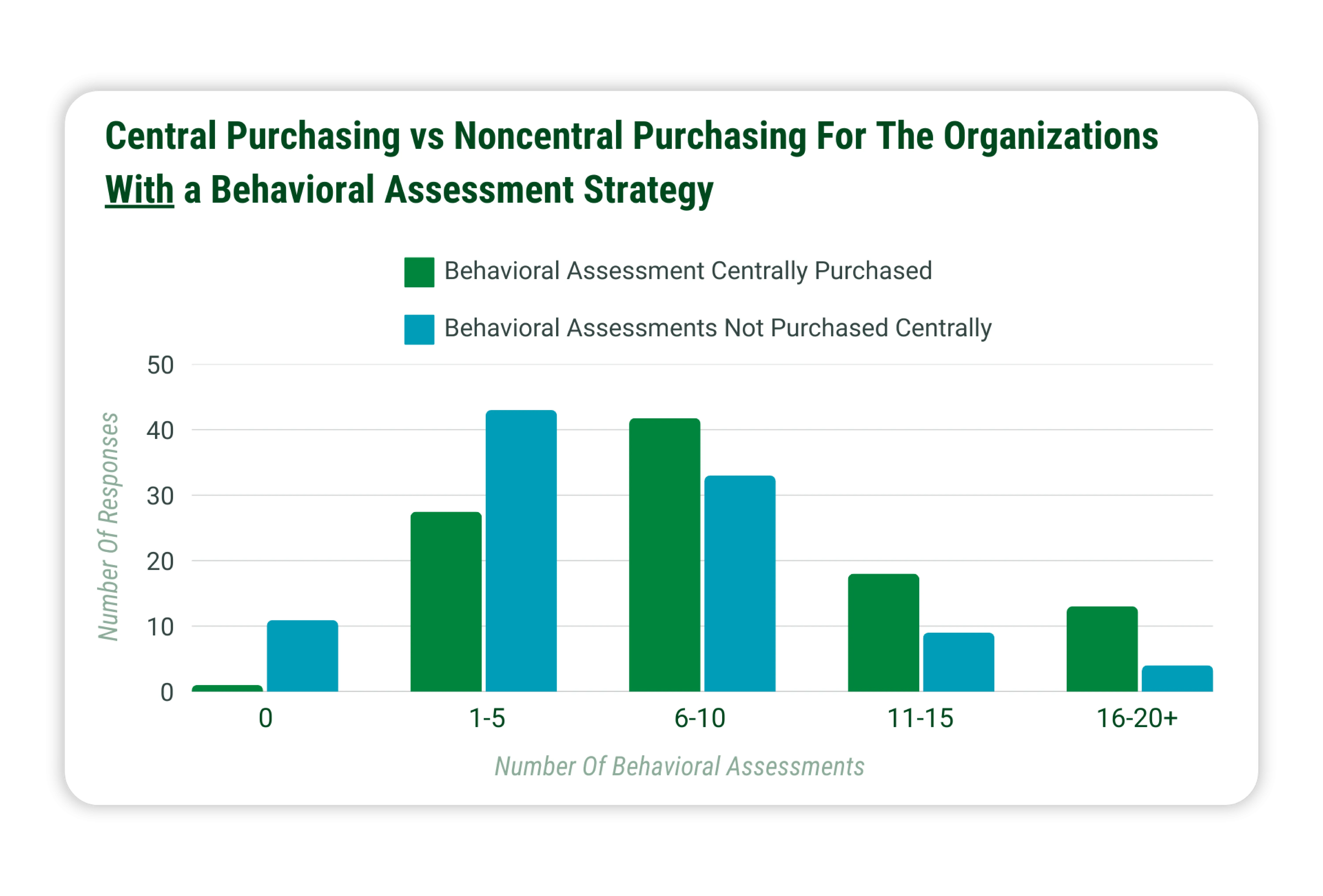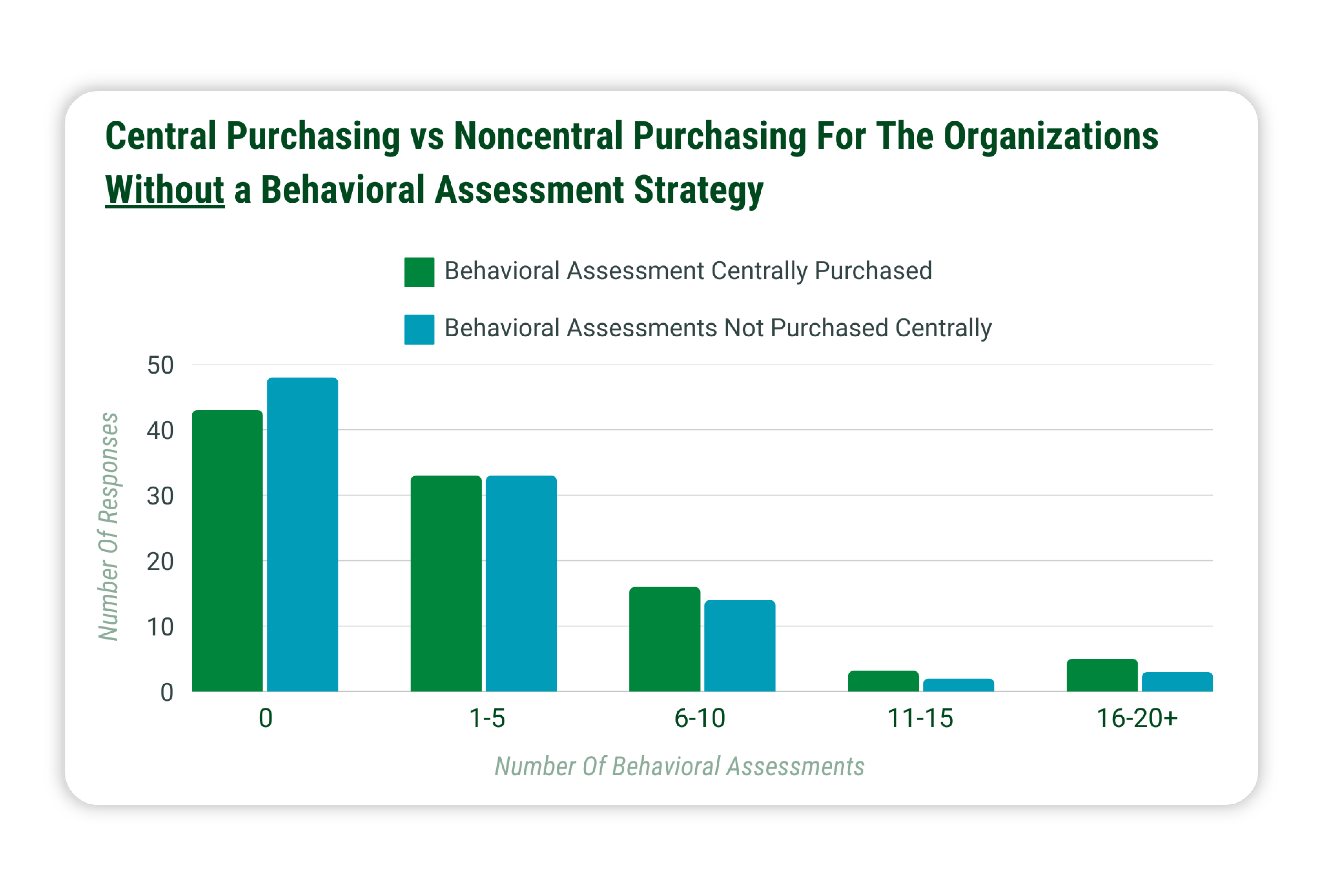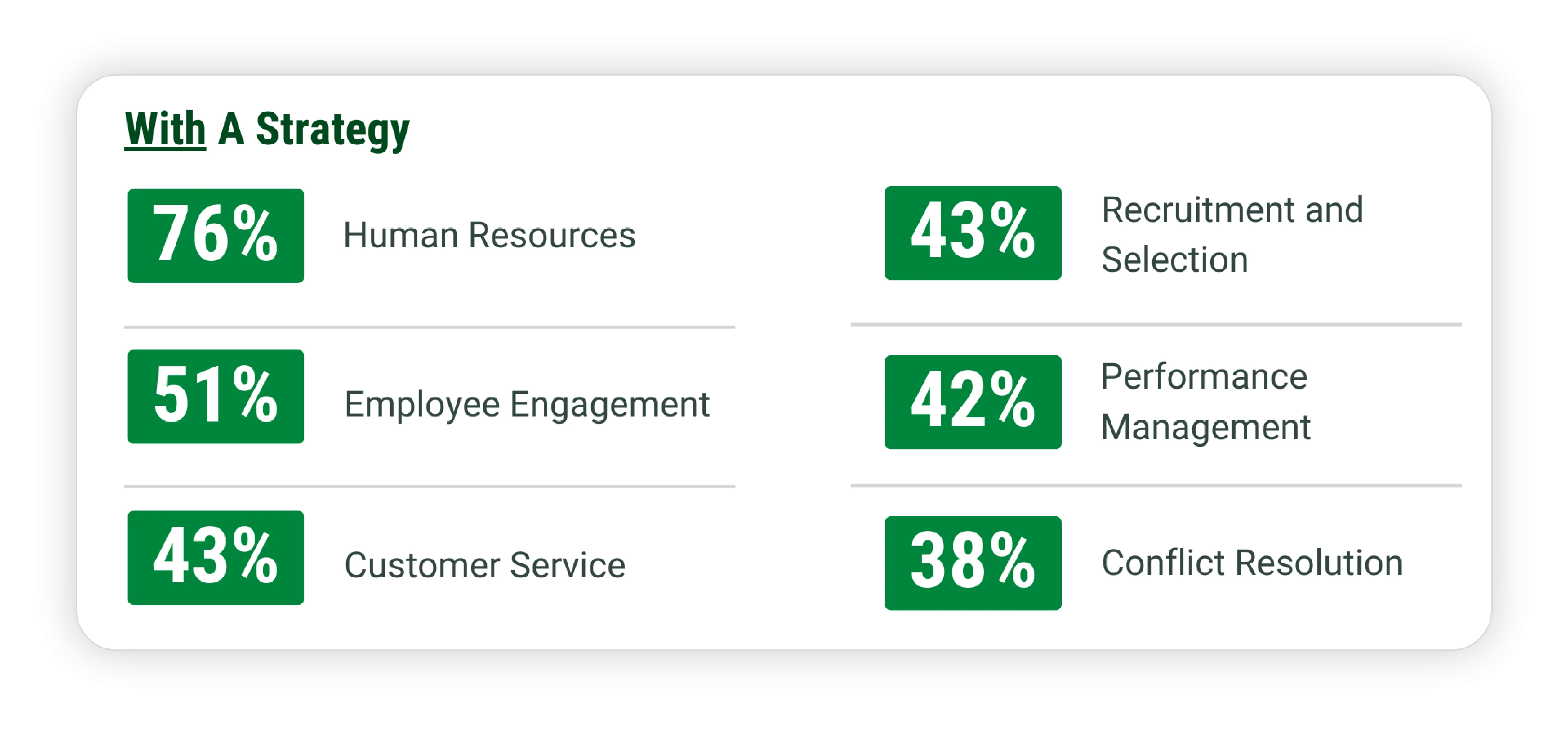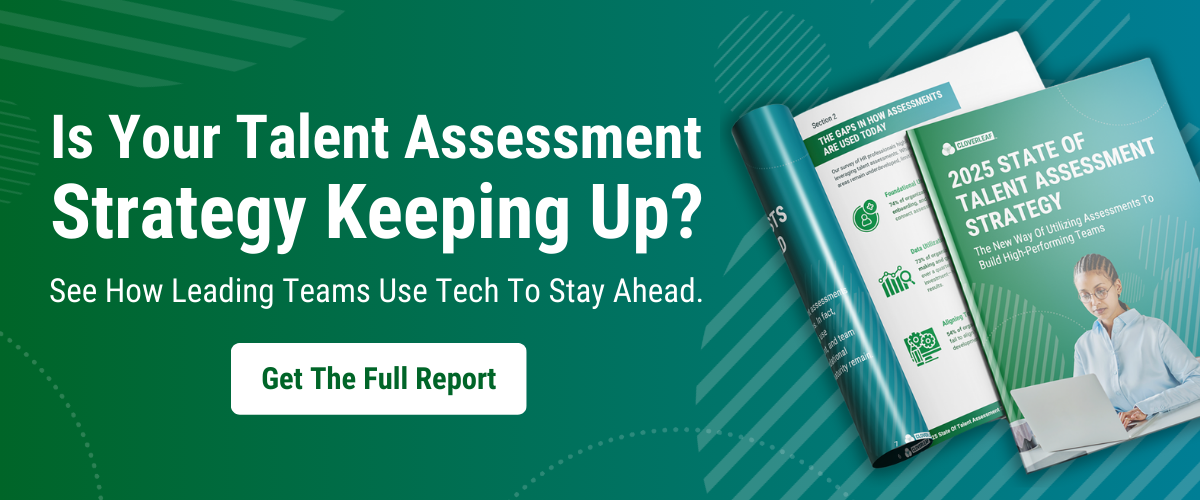Talent assessments aren’t new. Most companies already use them—in fact, 80% of Fortune 500 companies rely on them.
Unfortunately, many of them do not have a clearly defined strategy in place for their use. And for companies who have invested in a talent assessment strategy, many challenges still arise in getting the most out of their investment.
Our survey of 155 talent leaders uncovered surprising insights into how top organizations are leveraging talent assessments to drive results—and where others are falling short, including the urgent need for a new talent assessment approach in the 21st century.
👉 41% of organizations don’t have a strategy for talent assessments—despite investing in them.
👉 Most assessments are used in silos, meaning different teams choose their own tools without a shared approach.
👉 Only 50% of companies with a talent assessment strategy formally incorporate EEOC compliance guidelines, leaving them vulnerable to legal risks and potential bias in hiring and development.
Why 41% of Companies Lack a Talent Assessment Strategy—And the Risks They Face
On average, organizations with over 1,000 employees use 20 different behavioral assessments while those with more than 5,000 employees use an average of 35. Yet, 41% of these companies do not have a talent assessment strategy. Why? Most organizations indicate its not a priority for senior leadership or they are overwhelmed by other priorities and changes.
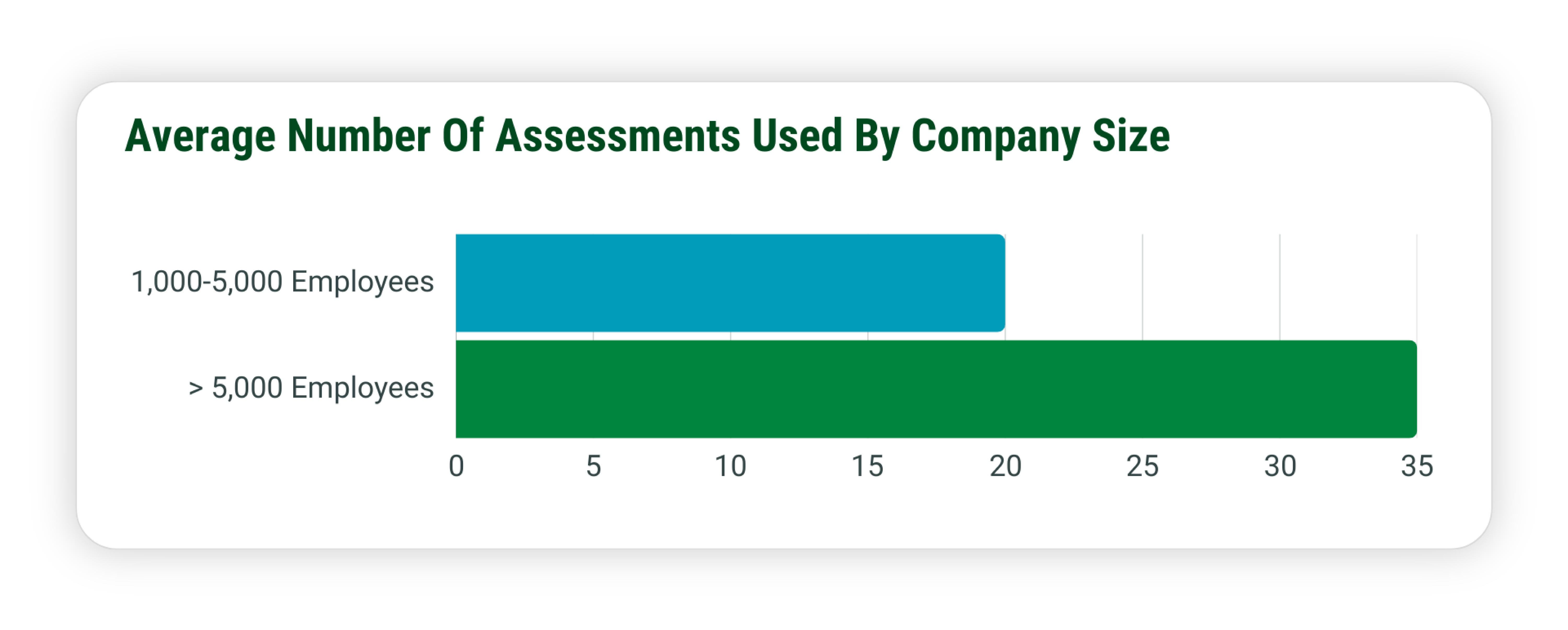 Not having a talent assessment strategy is a dangerous proposition as stories hit the media regularly about the misuse of talent assessments, including violation of EEOC guidelines where uninformed leaders make hiring or firing decisions based on a behavioral assessment.
Not having a talent assessment strategy is a dangerous proposition as stories hit the media regularly about the misuse of talent assessments, including violation of EEOC guidelines where uninformed leaders make hiring or firing decisions based on a behavioral assessment.
Additionally, a lack of strategy risks considerable loss from the company’s talent assessment investment. This is emphasized when noting that the 70% of talent leaders who do have a talent assessment strategy rate this investment as very or extremely important to their organization’s overall people strategy.
And when you consider that 67% of survey respondents indicate behavioral assessments enhance employee performance, the impact of not having a talent assessment strategy becomes much greater.
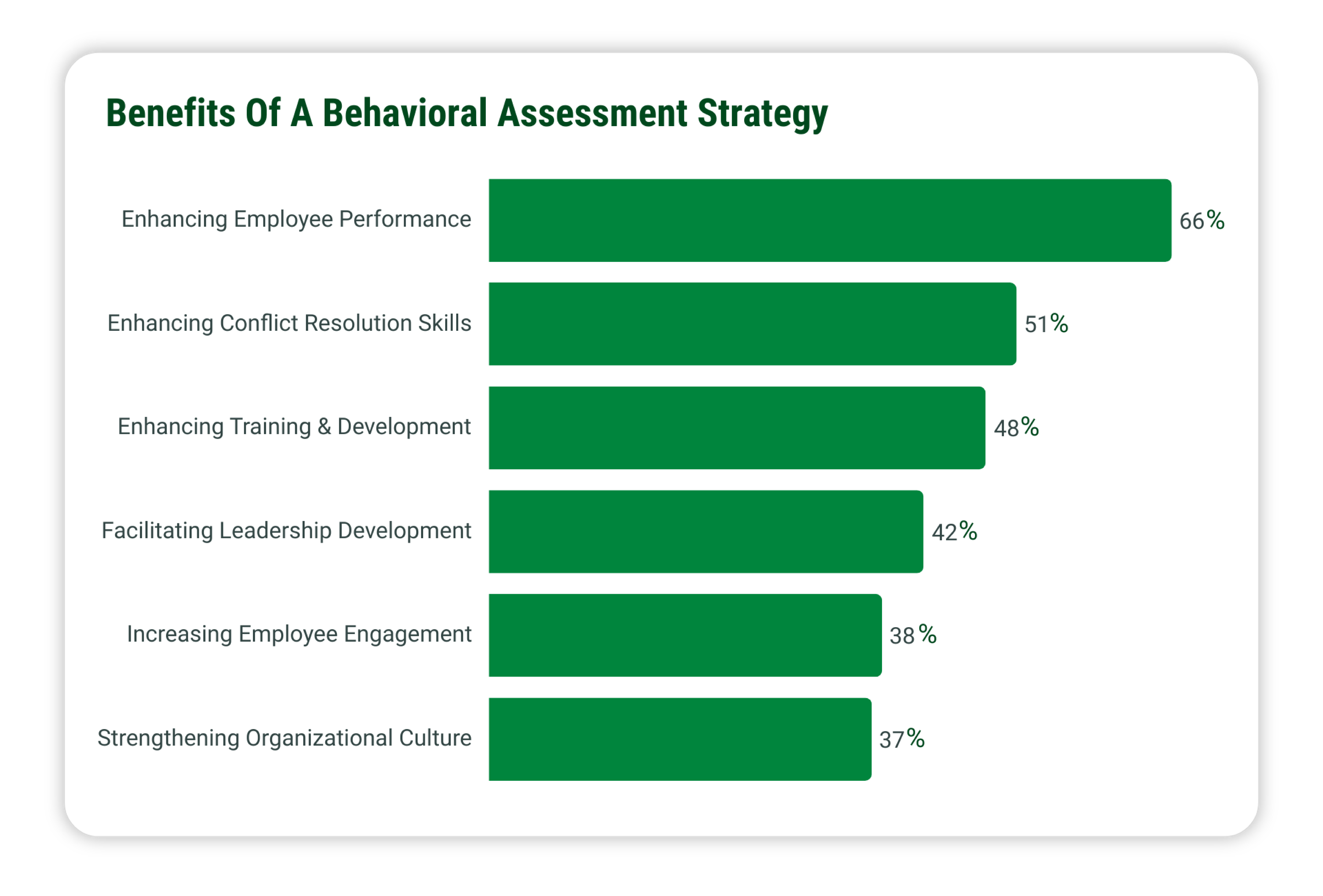 This fragmented, one-off approach means that talent assessments—one of the most powerful tools for hiring smarter, developing leaders, and retaining top talent—end up underutilized and undervalued.
This fragmented, one-off approach means that talent assessments—one of the most powerful tools for hiring smarter, developing leaders, and retaining top talent—end up underutilized and undervalued.
What’s missing? An intentional, tech-powered strategy that integrates assessments across the employee lifecycle.
A New Era for Talent Assessments
Companies that get talent assessments right are seeing major advantages:
✅ Stronger leadership pipelines: using assessments for succession planning, not just hiring.
✅ More engaged employees: leveraging assessment insights to create meaningful development pathways.
✅ Higher-performing teams: using shared language and insights to navigate communication, feedback, and collaboration.
The answer is clear: Companies who clearly define and manage their talent assessment strategy have a leg up on getting more ROI. And the companies who invest in technology to empower their assessments will deliver much more value for their employees and company as a whole.
What You’ll Find in This Article
- Why most talent assessment strategies fail—and how to fix them
- How to choose the right assessment tools for your team’s needs
- The impact of centralized vs. siloed assessment strategies
- How technology transforms assessments into continuous development tools
If your talent assessment strategy isn’t driving measurable results, you’re leaving value on the table. Let’s change that.
Get the full report to build a talent assessment strategy that works as hard as your team.
The Hidden Costs of a Poorly Executed Talent Assessment Strategy
It should come as no surprise that of the companies without a talent assessment strategy, very few are purchasing assessments through HR. The majority of companies have teams or departments investing in talent assessments on their own, without oversight from HR.
What is surprising is that even with an assessment strategy, many assessments remain non-centralized.
Almost all companies (89%) had at least 1 assessment being purchased on a one-off basis. Even more concerning, more than 50% of organizations had 5 or more assessments being purchased outside of HR and 25% with 10 or more assessments.
Data does show that as organizations invest in more assessments, they begin to centralize their assessments throughout one department. However, not funneling all assessment purchases through one department means missing out on cost savings and the opportunity for a shared learning language among employees.
This highlights the difficulty companies face in integrating assessments, largely due to outdated technology and a fragmented assessment market, emphasizing the need for a platform that unifies multiple assessments.
When talent assessments are purchased outside of the HR function a number of challenges arise:
- High Cost: There is little to no transparency in how much is being spent and by whom, which means lost opportunity for cost-savings from bulk negotiation.
- Compliance Risks: Purchasing talent assessments without the proper guidelines from HR brings about risks like the use of non-validated assessments, improper interpretation and misuse of data, and even EEOC violations.
- Disjointed Employee Experience: When employees use different assessments for different use cases, they don’t develop a common language and lack a shared growth experience across departments.
- Loss Of Impact: When assessments are used for one-off scenarios, the learnings are often quickly forgotten, but HR can help ensure they are incorporated into the entire employee life cycle for future growth.
All of these findings point to an urgent shift needed in the expensive and disjointed talent assessment market. Organizations are missing out on the greatest benefits of behavioral assessments despite massive investments in the industry.
Technology within the talent assessment industry is making it possible for companies to overcome the challenges we heard from talent leaders in this survey, and further enhance employee performance and engagement.
Let’s talk about how to make that happen.
How to Match Assessments to Organizational Challenges
Most HR and talent leaders already leverage assessments—but choosing the right tool for the right challenge is where many strategies can fall short. When assessments aren’t aligned with business goals, they fail to drive meaningful impact and risk becoming one-off exercises instead of continuous development tools.
For example, here’s how to match some of the most widely used and validated assessments to the challenges you’re solving:
- DISC → For improving communication & collaboration
Helps teams understand different work and communication styles, reducing friction and improving cross-functional collaboration. - 16 Types (MBTI-Based) → For decision-making alignment & strategic collaboration
Identifies cognitive diversity within teams, helping leaders understand how different thinking styles shape problem-solving and innovation. - Enneagram → For emotional intelligence & resilience in leadership
Provides insight into stress triggers and core motivations, helping leaders manage pressure, make better decisions, and build stronger relationships. - StrengthsFinder → For maximizing engagement & productivity
Shifts the focus from “fixing weaknesses” to leveraging natural strengths, helping employees and leaders work in ways that energize them.
Other tools like 360-degree reviews and development assessments can provide valuable feedback, but they often lack a mechanism for ongoing improvement. These conversations can become more personalized, focused, and actionable when combined with digital coaching insights from talent assessments.
Instead of waiting for periodic feedback cycles, employees and leaders can receive real-time, contextual coaching nudges that reinforce their development goals in the moments that matter.
How to Make Assessments Actionable
Assessments provide valuable insights, but without personalization and continuous reinforcement, they often fail to drive lasting change. Many organizations use assessments as static tools—one-time reports that sit in a file rather than shaping daily interactions and long-term development.
Technology powers the opportunity to turn assessment results into continuous and personalized learning journeys for the entire employee lifecycle. Instead of a PDF with assessment results that are rarely returned to by employees, they can not get daily insights that coach them on their strengths.
Here’s how to make sure your talent assessments translate into real impact:
1. Move from One-and-Done to Continuous Growth
Assessments provide a snapshot of individual strengths, communication styles, or leadership potential—but without ongoing reinforcement, these insights quickly fade. Sustained learning happens when assessments are integrated into an employee’s daily workflow, providing just-in-time nudges and continuous feedback.
- Instead of a single feedback session, create a system where insights are reinforced over time through coaching nudges, team discussions, and leadership development activities.
- Use technology to re-engage employees with their assessment results in relevant moments—like preparing for a high-stakes meeting or giving constructive feedback.
- Shift from a passive report to an interactive coaching experience, where employees receive actionable guidance based on their working style and team dynamics.
2. Personalize Assessments to Team and Organizational Goals
Traditionally, assessments are about the results for just yourself. However, there is power in making this a shared team experience. With technology, assessment results can become a coaching opportunity for how to best engage with colleagues based on their unique working styles.
- Use assessments to build high-functioning teams. Rather than simply identifying personality traits, leverage assessment data to enhance collaboration, resolve conflicts, and optimize team structures.
- Align assessments with business challenges. For example, if an organization struggles with leadership agility, use assessment insights to identify gaps in decision-making styles, resilience, and adaptability.
- Customize feedback based on role and responsibilities. A senior leader and a new manager will engage with assessment data differently—tailor recommendations accordingly.
3. Embed Insights Into Daily Workflows
No one logs into a platform just to review an old assessment report. To make assessments actionable, they must be part of the tools and processes employees already use.
- Deliver micro-coaching at the right moment. Instead of expecting employees to remember what they learned in an assessment workshop, embed bite-sized, actionable insights into their email, calendar, or team collaboration software.
- Reinforce growth through team interactions. Help employees apply assessment insights in 1:1s, team meetings, and feedback conversations—so they aren’t just learning in isolation.
- Make development part of the workflow. AI-driven coaching nudges can suggest how to adapt communication for a specific colleague, provide conflict resolution tips before a tough conversation, or offer leadership reminders ahead of a decision-making meeting.
4. Bridge the Gap Between Assessments and Actionable Feedback
Assessment results shouldn’t be the end of the journey—they should be the beginning of meaningful development. The key is transforming assessment data into personalized, real-world coaching experiences that help employees and leaders continuously improve.
- Assessment insights should inform 360-degree feedback so employees receive data-driven, context-specific coaching rather than generic evaluations.
- Managers should have access to real-time insights that help them support and develop their teams—not just once a year, but in every key moment of leadership.
- Feedback loops should be dynamic and iterative, allowing employees to track their growth over time rather than seeing assessments as a one-time snapshot of who they are.
For example, instead of a standard 360-degree feedback process, use assessment insights to structure more effective performance reviews, helping employees and managers have more meaningful, targeted conversations that drive real development.
A well-executed talent assessment strategy creates a system where insights translate into growth, leadership agility, and high-performing teams.
Organizations that integrate assessments into leadership, decision-making, and coaching will build adaptable, engaged, high-impact teams.
The bottom line? It’s not just about the data you collect—it’s about how you use it to build better teams, stronger leaders, and a more connected organization.
Is Your Talent Assessment Strategy Keeping Up?
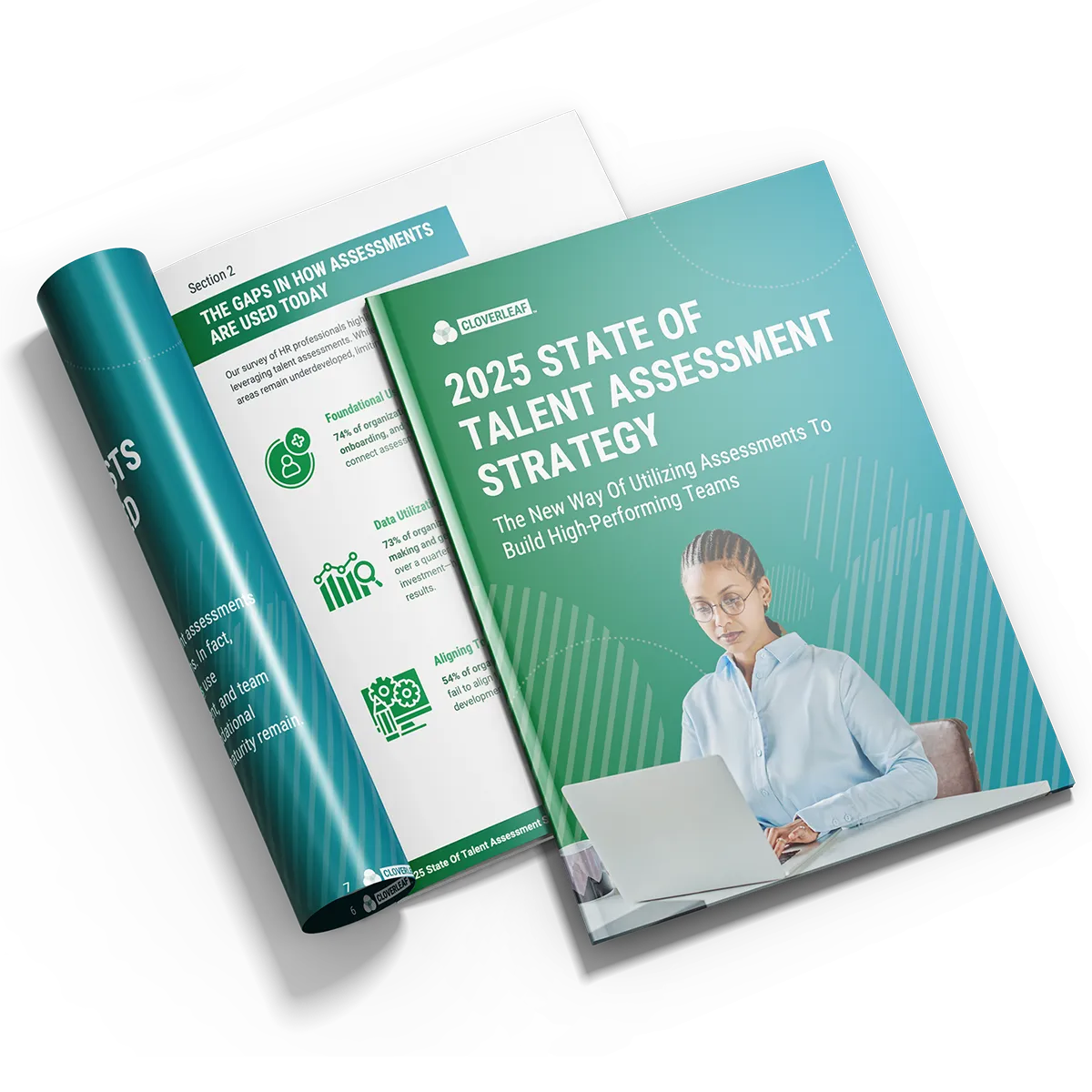
How To Integrate A Talent Assessment Strategy In 3 Steps
A well-executed talent assessment strategy isn’t just about choosing the right tools—it’s about embedding them into the fabric of your organization. Without a clear strategy, assessments remain underutilized, disconnected from business objectives, and a missed opportunity for leadership development and team performance.
To move from fragmented, one-off assessments to a fully integrated approach that drives measurable impact, follow these three steps:
Step 1: Centralize Your Talent Assessment Strategy
Results of our survey showed organizations invest in many different assessments for different use cases throughout the employee lifecycle. Companies that use a single platform to consolidate all of their talent assessments will see cost savings, more successful guidance from HR on the use of assessments, and a common shared development experience for all employees.
How To Centralize Your Talent Assessments:
- Establish Central Oversight: Ensure that HR or People Strategy teams manage assessments to prevent redundant spending and create a unified, organization-wide approach.
- Set Clear Standards for Compliance & Validation: Align assessments with EEOC regulations and ensure all tools used are scientifically validated to mitigate legal risks and improve decision-making accuracy.
- Link Assessments to Business Priorities: Assessments should not exist in isolation—integrate them into leadership development, succession planning, and performance management strategies to maximize their impact.
Despite the widespread use of assessments, only 34% of organizations have a structured procurement process. This leads to duplicate purchases, misalignment, and a lack of ROI tracking—a major inefficiency that can be solved through centralization.
Companies that centralize their assessment strategy:
- Lower costs by negotiating better pricing and eliminating redundant purchases.
- Ensure ethical, validated use of assessments across hiring and development.
- Create consistency across teams, helping employees develop a shared language for growth and collaboration.
Step 2: Embed Assessments Into Daily Work
Assessments shouldn’t be a one-and-done event. Yet, while many companies review assessments during hiring or annual performance reviews, they struggle to incorporate them into ongoing development.
For assessment insights to drive real behavior change, they need to be part of employees’ daily interactions, decision-making, and coaching experiences.
How To Get More From Your Assessment Insights Everyday
Use assessment insights to improve how teams work together every day:
- Leadership Development: Help managers build self-awareness and refine their leadership style based on their strengths and communication tendencies.
- Team Collaboration: Foster stronger team dynamics by aligning decision-making approaches, work styles, and feedback preferences based on assessment insights.
- Conflict Resolution: Equip employees and leaders with actionable strategies for navigating difficult conversations, reducing friction, and strengthening trust.
- Just In Time Coaching: Use AI-powered coaching nudges to reinforce key behaviors in the flow of work, offering employees just-in-time reminders that translate insights into action.
Tech-driven coaching ensures assessments are not forgotten after a single use but instead deliver continuous learning and development over time.
When organizations embed assessments into daily workflows, they:
- Turn assessment insights into a competitive advantage to help employees adapt, communicate, and collaborate more effectively.
- Create a culture of growth where learning is ongoing, not limited to scheduled training sessions.
- Ensure leadership development is a continuous process rather than an occasional initiative.
Step 3: Measure & Optimize for Business Impact
Without measurable outcomes, talent assessments risk becoming just another HR initiative—instead of a strategic driver of business success.
The key to sustained impact is tracking the effect of assessments on performance, leadership, and team success.
How to Measure Your Assessment Strategy Success:
Go beyond hiring metrics – Track how assessments influence:
- Team productivity improvements – Do assessment-driven coaching tools improve collaboration and efficiency?
- Leadership effectiveness ratings – Are managers applying insights to lead with greater confidence and adaptability?
- Employee retention & engagement – Are employees staying longer and feeling more engaged because of assessment-driven development?
Leverage assessment insights for ongoing coaching and performance reviews.
- Ensure assessment results feed into personalized coaching plans, rather than being reviewed once a year.
- Create dynamic feedback loops to continuously refine how assessments support business goals.
- This allows leaders to adjust their approach based on real-time team dynamics and business needs.
Companies that track assessment-driven impact see:
- Stronger alignment between leadership development, engagement, and business performance.
- Higher retention rates—employees are more likely to stay when they feel supported and developed.
- A culture of continuous improvement—where teams actively use assessments to improve collaboration and effectiveness.
Limited Impact
Organizations with an assessment strategy are more likely to maximize their investments by incorporating the results into multiple aspects of an employee’s experience, with less than half of respondents without a strategy using assessments in the most common cases.
However, even most of those with a strategy are still not using assessments in some of the most powerful places that determine an employee’s development and engagement, such as leadership development, conflict resolution, performance management and team collaboration.
Many can argue these are the exact scenarios these assessments are created to support, and indeed most respondents said the main benefits of assessments lie in employee engagement and conflict management (see above).
Why is it that organizations who have already invested the money into these assessments are not also applying the benefits in the critical daily moments employees face? It is time for assessment results to come out of static PDFs and into the daily moments throughout the talent lifecycle.
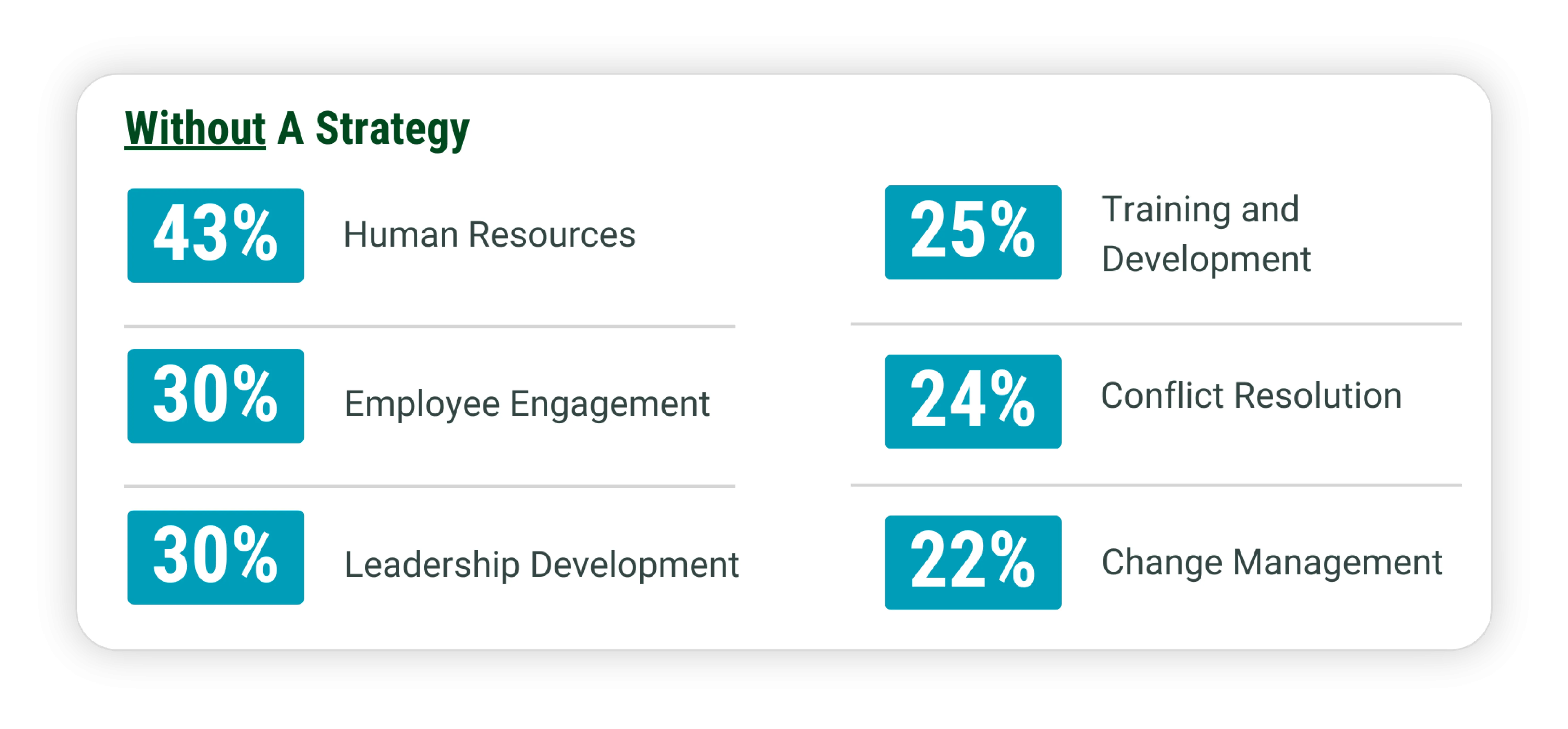
The Future of Talent Assessments: The Business Case for Change
Talent leaders know the value of assessments—they’ve been a core part of hiring, leadership development, and team building for years. But as the workplace evolves, so do the demands on talent strategies.
Many organizations are already investing in assessments, yet maximizing their impact remains a challenge. Too often, insights are captured in reports that don’t translate into sustained behavior change or measurable business outcomes.
Key Trends Shaping the Future of Talent Assessments
1. Personalization at Scale
Technology-powered platforms can now provide individualized coaching based on an employee’s strengths, behavioral patterns, and team dynamics—ensuring insights are timely, relevant, and actionable.
2. Team-Focused Development
Future-forward assessment strategies help teams navigate collaboration, conflict resolution, and decision-making by providing shared insights that improve alignment and communication.
3. Integration With The Flow Of Work
Insights lose value when they’re buried in reports. The future of effective assessment strategies lies in seamless integration—embedding insights into the tools employees already use, like Slack, Microsoft Teams, email, and meeting prep platforms. This enables real-time coaching that supports better interactions, decision-making, and leadership development.
4. Continuous Feedback & Growth
Companies that embed assessments into ongoing coaching and development will see stronger retention, more effective leadership pipelines, and greater adaptability across teams. Assessment insights should be refreshed over time, evolving with an employee’s growth rather than remaining static.
Organizations investing in tech-enabled assessment platforms are experiencing stronger collaboration, higher engagement, and more effective leadership development.
If your talent assessment strategy isn’t embedded into the flow of work, it’s not reaching its full potential. Organizations that use assessments to generate just in time coaching and continuous development see stronger leadership, better collaboration, and sustained business performance.
Ready To Turn Assessments into Actionable Development?
The success of talent assessment strategies lies in their ability to amplify organizational impact through technology, transforming everyday interactions into opportunities for sustained growth and development.
Today’s tools harness assessment data to deliver ongoing, personalized insights that seamlessly integrate into employees’ daily workflows. By embedding these insights into tools like email platforms or team collaboration software, organizations can provide timely learning opportunities that are practical, relevant, and impactful.
Unlock insights, align strategies, and drive growth with talent assessments that transform individuals, teams, and organizations.
Let’s develop the future workforce together.


